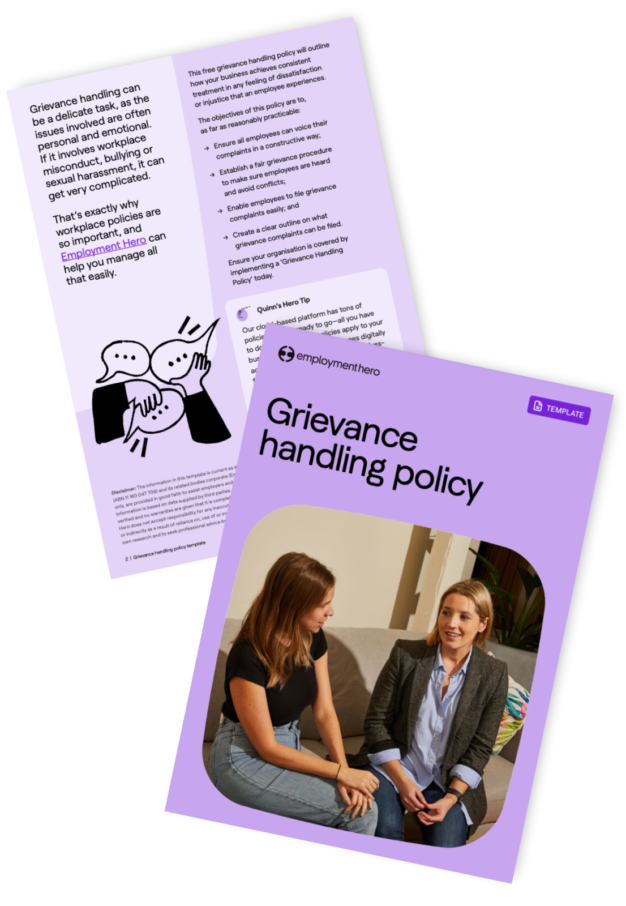
Ensure your organisation is covered by implementing a Grievance Handling Policy.
Download our fully customisable, printable version now. Entirely free.

Using this grievance handling policy template
This free grievance handling policy will outline how your business achieves consistent treatment in any feeling of dissatisfaction or injustice that an employee experiences.
The objectives of this policy are to, as far as reasonably practicable:
- Ensure all employees can voice their complaints in a constructive way
- Establish a fair grievance procedure to make sure employees are heard and avoid conflicts
- Enable employees to file grievance complaints easily
- Create a clear outline on what grievance complaints can be filed
What is a grievance handling policy?
A grievance handling policy basically outlines how an organisation deals with complaints or grievances raised by its employees. The policy sets out the steps that employees can take to report their grievances, as well as the process for investigating and resolving those grievances.
Why is it important to have a formal grievance procedure policy?
A well-defined grievance handling policy is essential because it ensures that employees feel heard, valued, and respected, and that their concerns are taken seriously. It can also help to prevent conflicts from escalating into more serious issues that could affect overall employee morale and productivity. Here are five main reasons why it’s so important:
1. Ensures fairness and consistency
An official grievance procedure policy provides a consistent and fair process for handling employee complaints. This helps to ensure that all employees are treated equally, have transparency over the entire process, and complaints are addressed in a timely and appropriate manner.
2. Protects the rights of employees
Having a grievance procedure policy provides a clear process for employees to raise concerns about workplace issues without fear of retaliation. It helps to protect the rights of employees by ensuring that they have an avenue to be heard, feel safe enough to raise any complaints, and have those concerns addressed accordingly.
3. Maintains a positive work environment
A workplace grievance occurs when there an employee is discontent, or feels victimised at work. It could arise from the management style of their direct supervisor, toxic staff, or miscommunication and misunderstandings in the workplace. If it isn’t handled properly, it could negatively affect overall morale and productivity.
A formal grievance procedure policy can help to change that by providing a structured process for resolving conflicts and preventing them from escalating. This can lead to better employee morale and job satisfaction as grievances get resolved, according to the policy.
4. Ensures legal compliance
In some countries like Australia and the UK, having a formal grievance procedure policy is a legal requirement. Failure to comply with these requirements can result in legal liability for employers. The policy should set out the steps that employees can take to raise a grievance, the timeframe for responding to grievances, and the options for appeal.
The legal requirements for a grievance handling policy can vary, depending on the size of the organisation, the industry, and other factors. Consult legal experts in your country to ensure your organisation is meeting all legal requirements.
5. Avoid legal implications
A clear and consistent process for addressing employee complaints can help to resolve issues before they become more serious. Having a formal grievance procedure policy nips problems in the bud by preventing conflicts from escalating. When complaints are resolved in a timely manner, it prevents conflicts from resulting in costly litigation.
What are the procedures involved in grievance handling?

The grievance handling procedure can vary, depending on the organisation and the nature of the grievance. However, here are some steps that are typically involved in the grievance handling process:
1. Receiving the grievance
The first step in the grievance handling process is for the employee to raise the grievance with their direct supervisor or HR department. The employee should provide a clear and detailed explanation of the grievance, including any relevant facts or evidence.
Generally, it is recommended that the employee files the grievance in writing using a grievance form so that there is a clear record of it. Most grievance procedures will also require that employees submit their grievances within a specific timeframe after the event or incident.
2. Investigating the grievance
Once the grievance has been received, employers should conduct a thorough investigation to gather as much information as they can about the situation. This may involve interviews with the employee, the coworker involved, and other relevant parties, as well as any other pertinent information they need to address the issue properly.
3. Evaluating the grievance
Once the investigation is complete, the organisation should evaluate the grievance to determine whether it has merit. This may involve comparing the facts of the case to the organisation’s policies and procedures, as well as any relevant laws or regulations.
4. Resolving the grievance
If the grievance is determined to have merit, you will have to take the necessary steps to resolve the issue. This may involve a range of actions, such as issuing a formal warning letter, mediating through a grievance handling meeting, or taking disciplinary action against the other parties involved.
The HR representative typically takes up the role of a ‘grievance handler’ to manage the entire process and ensure that matters discussed are kept confidential. They should explain to all the parties involved that the grievances can be resolved if they are open and willing to explore all the solutions available. They should also encourage feedback and suggestions from all parties to reach an ideal resolution.
5. Communicating the decision
Once the grievance has been resolved, you can then communicate the decision to the aggrieved employee in writing. This can include an explanation of the decision, how you arrived at that decision, any actions that will be taken as a result of the grievance, and any options for appeal or further review.
Tips for employers handling grievances in the workplace
Grievance handling can be incredibly complicated with multiple parties involved, or difficult to put a finger on because it involves intangibles like individual behaviour and conduct. Here are some tips that can help you better handle grievances in the workplace:
1. Act promptly
Time is of the essence when a grievance is filed. Employers should act promptly in response to grievances, to show that you take your employee concerns seriously. Delaying any action could make the situation worse and could lead to increased frustration or dissatisfaction. Employers need to be quick in dealing with any hint of trouble before it gets out of control.
2. Appoint a well-trained and effective ‘grievance handler’
The ‘grievance handler’ is the main point of contact for the aggrieved employee and also the main mediator overseeing the entire resolution process, so it’s important that they’ve been well-trained. You’ll want them to have certain qualities, such as a problem-solving attitude so they are open-minded and willing to explore ways to resolve the grievance with the employee.
They should be responsible and ensure that all matters relating to the employee and the grievance discussed are kept confidential. They should also be meticulous, careful, and conscientious about note-taking to ensure accurate facts and information.
It’s also crucial that they practise active listening. Grievance handlers need to exercise empathy, and try to understand the feelings of dissatisfaction and distress that the aggrieved employee is experiencing.
Using inclusive language like ‘let’s work together’ and ‘resolve our problem’ will also help to reassure the aggrieved employee — it makes the grievance less of an individual problem, and helps them be less defensive when they understand that the grievance handler is there to support them.
Ultimately, the grievance handler needs to remain polite, placid and professional throughout the entire process. Should the aggrieved employee get too agitated, it’s crucial that they are able to stay collected, get the employee to calm down, and not involve their own emotions or biassed opinions in the process.
3. Address the root of the issue
Is there a deeper, underlying issue that led to the grievance? It’s vital that you investigate thoroughly and address the root problem, rather than arrive at an easy solution just to placate the aggrieved employee.
If there are structural or cultural changes that need to be made internally within the company, this is the best time to do so. Addressing the underlying problem can help prevent similar grievances from arising in the future, and improve overall employee satisfaction.
4. Document the entire process
As always, honesty and transparency is key. Documenting the entire grievance handling process, including any actions taken and decisions made, can help to demonstrate that the process was fair and impartial, and can be used as a reference in the future.
Handling workplace grievances with Employment Hero
Grievance handling can be a delicate task, as the issues involved are often personal and emotional. If it involves workplace misconduct, bullying or sexual harassment, it can get very complicated.
That’s exactly why workplace policies are so important, and Employment Hero can help you manage all that easily. HR policies written by HR experts? You got it.
Our cloud-based platform has tons of policies that are ready to go — all you have to do is choose which policies apply to your business, and have your employees digitally acknowledge each document. It’s so fuss-free and there’s no paperwork involved.
Download our fully customisable, printable version now. Entirely free.

